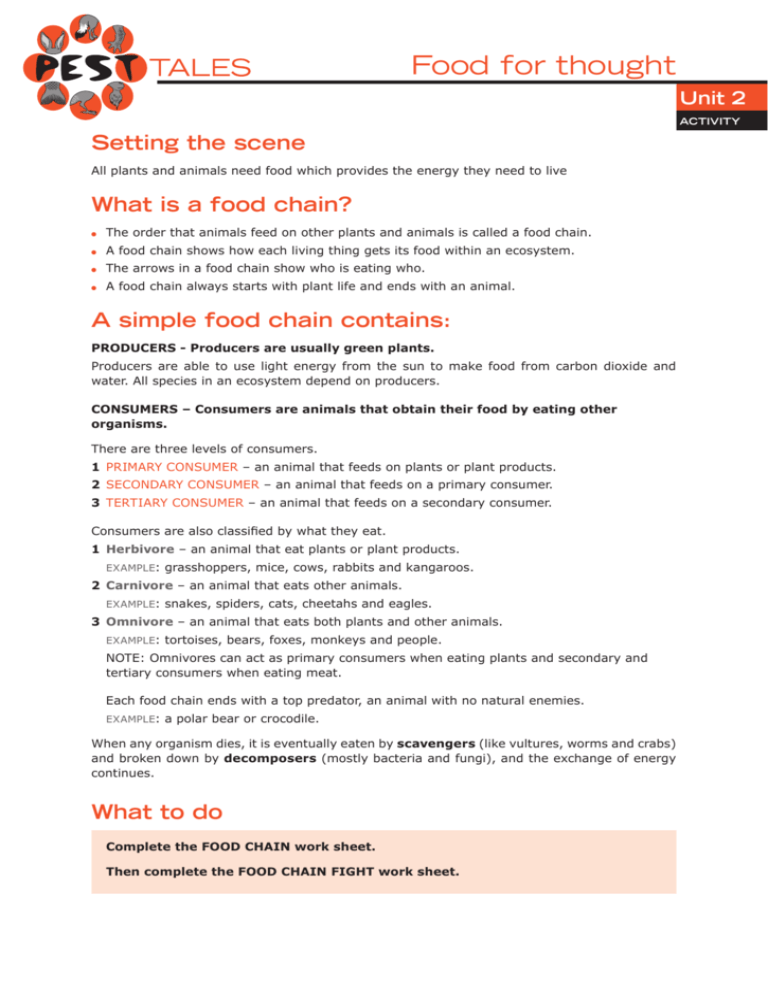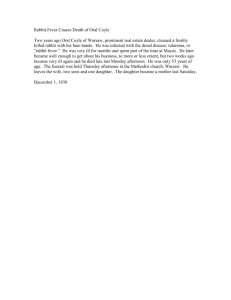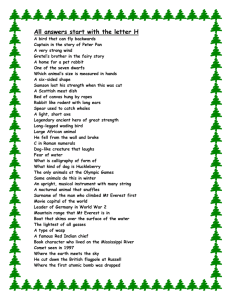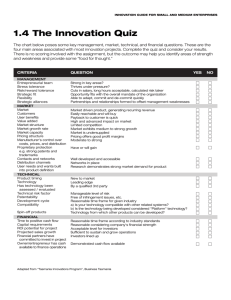Food for thought
advertisement

Food for thought Unit 2 activity Setting the scene All plants and animals need food which provides the energy they need to live What is a food chain? l The order that animals feed on other plants and animals is called a food chain. l A food chain shows how each living thing gets its food within an ecosystem. l The arrows in a food chain show who is eating who. l A food chain always starts with plant life and ends with an animal. A simple food chain contains: Producers - Producers are usually green plants. Producers are able to use light energy from the sun to make food from carbon dioxide and water. All species in an ecosystem depend on producers. Consumers – Consumers are animals that obtain their food by eating other organisms. There are three levels of consumers. 1 Primary consumer – an animal that feeds on plants or plant products. 2 Secondary consumer – an animal that feeds on a primary consumer. 3 Tertiary consumer – an animal that feeds on a secondary consumer. Consumers are also classified by what they eat. 1 Herbivore – an animal that eat plants or plant products. Example: grasshoppers, mice, cows, rabbits and kangaroos. 2 Carnivore – an animal that eats other animals. Example: snakes, spiders, cats, cheetahs and eagles. 3 Omnivore – an animal that eats both plants and other animals. Example: tortoises, bears, foxes, monkeys and people. Note: Omnivores can act as primary consumers when eating plants and secondary and tertiary consumers when eating meat. Each food chain ends with a top predator, an animal with no natural enemies. Example: a polar bear or crocodile. When any organism dies, it is eventually eaten by scavengers (like vultures, worms and crabs) and broken down by decomposers (mostly bacteria and fungi), and the exchange of energy continues. What to do Complete the FOOD CHAIN work sheet. Then complete the FOOD CHAIN FIGHT work sheet. Food for thought Unit 2 What to do next Create your own food chain based on animals found in Australia. Your food chain must include the following: l a producer l a primary consumer l a secondary consumer l a tertiary consumer l a rabbit Answer the following questions: 1. What would happen to the plant and animals if the rabbit was removed from your food chain? 2. Who would benefit from the removal of the rabbit from your food chain? Make sure you say why in your answer. 3. Who would not benefit from the removal of the rabbit from your food chain? Make sure you say why in your answer. What would happen if the rabbit is removed from the food chain? Which animals and plants would benefit and which animals would not benefit? What to do next Introduce a feral predator to your food chain such as a cat or a fox. Write a story about survival from the point of view of an animal in the middle of your food chain. Feral Fact Tasmania was one of the last places in Australia where foxes had not established, at least until now. An unknown number of foxes are now in Tasmania. No one know how they got there, but if their numbers start to increase then Tasmania’s wildlife will be under serious threat. A healthy fox population may impact as many as 77 native animal species living in Tasmania. Many of these animals are already extinct or endangered on mainland Australia due to the impact of foxes and other introduced pest species. activity



